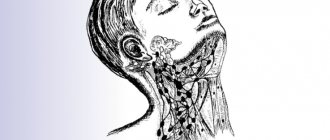When is a patent foramen ovale physiological?
The foramen ovale is the opening between the right and left atria. It is open only during the child’s intrauterine life. Oxygen is supplied to the fetus through the umbilical cord; the lungs do not function and do not require a lot of nourishing blood. Therefore, while the pulmonary circulation is closed, part of the blood is discharged from the right atrium to the left through the oval window. The window is covered with a valve that functions like a door on a spring: it opens only towards the left atrium.
But everything changes with the birth of a child. After the first breath, the newborn’s lungs are cleared of intrauterine fluid, filled with air, and blood enters them through the pulmonary circulation. From now on, the work of the oval window is completed. In the left atrium, pressure increases, which tightly presses the oval window valve to the interatrial septum. This prevents the valve door from opening again and creates conditions for it to become overgrown.
What is this
This is the name given to the structural feature of the septum inside the heart, which is present in all children during intrauterine development and is often detected in a newborn. The thing is that the heart of a fetus functions somewhat differently than that of an infant or an adult.
In particular, in the septum separating the atria there is an opening called the oval window. Its presence is due to the fact that the fetal lungs do not work, and therefore little blood enters their vessels. The volume of blood that in an adult is ejected from the right atrium into the veins of the lungs, in the fetus passes through the hole into the left atrium and is transferred to the more actively working organs of the baby - the brain, kidneys, liver and others.
This window is separated from the left ventricle by a small valve that matures completely by the beginning of labor. When the baby takes his first breath and his lungs open, blood flows into them, which is accompanied by an increase in pressure inside the left atrium. At this moment, the oval window is closed by the valve, and then it gradually fuses with the septum. If the window closes prematurely, while still in utero, this threatens heart failure and even the death of the child, so the presence of an opening is important for the fetus.
Closing the window occurs differently for different children. In some, the valve grows to it immediately after birth, in others - during the first year, in others - by the age of 5. In some cases, the size of the valve is not sufficient to close the entire oval window, which is why the hole remains slightly open for life, and a small volume of blood is periodically discharged from the pulmonary circle into the systemic circulation. This situation is observed in 20-30% of children.
A foramen ovale that does not close completely after birth is not considered a defect in the septum that divides the atria, since the defect is a much more serious problem. It is considered a congenital defect, and LLC is classified as a minor anomaly, representing only an individual feature. With a septal defect, the valve is completely absent and blood can be discharged from left to right, which poses a health hazard.
Dimensions and standards
Closure of the oval window normally occurs within a period of 3 months to 2 years. But even at 5 years old, such a finding is considered normal.
According to statistics, 50% of healthy children aged 5 and 10–25% of adults have this feature. Separately, it is worth noting that it is not a vice. Doctors call it MARS - minor anomaly of the heart. It distinguishes the structure of the heart from the anatomical norm, but does not pose an immediate threat to health.
In 1930, T. Thompson and W. Evans examined 1,100 hearts, the results were as follows: 35% of those examined had an open foramen ovale, 6% of them had a 7 mm diameter (half of them were children under 6 months). In adults, large-diameter PFOs occurred in 3% of cases.
Window sizes can be different: from 3 mm to 19 mm (usually up to 4.5 mm). First of all, they depend on the patient’s age and the size of his heart. The indication for surgical treatment does not depend on the size of the window, but on how much it is covered by the valve and the degree of compensation.
Symptoms
More often, an open foramen ovale in the heart does not manifest itself in any way, or makes itself felt only by scanty and nonspecific symptoms.
Young children with this anomaly may experience:
- blueness or sharp pallor of the circumlabial area or nasolabial triangle during straining, screaming, crying, coughing or bathing;
- tendency to colds and bronchopulmonary diseases;
- slow weight gain.
Older children may have poor exercise tolerance, which manifests itself as increased heart rate and shortness of breath.
During puberty or during pregnancy, when a total hormonal change occurs in the body, provoking an increase in the load on the cardiovascular system, a patent oval window can manifest itself with frequent episodes of dizziness and headaches, fatigue and sensations of interruptions in the functioning of the heart. These manifestations are especially pronounced after intense physical activity. In some cases, such an anomaly in the development of the heart can lead to sudden and unmotivated fainting.
Non-closure of the oval window before the age of five indicates that, most likely, this anomaly will accompany the person throughout his life. At a young age and in the absence of cardiovascular lesions, it has practically no effect on his well-being and work activity, but after 40-50 years and the development of heart or vascular diseases, the oval window can aggravate the course of these ailments and complicate their treatment.
When does a patent foramen ovale become a pathology?
The presence of an oval window in itself is not a problem. After all, it does not cause circulatory problems, but functions only with a strong cough or heavy physical activity.
Problems arise in the following cases:
- when a child's heart enlarges with age, but the valve does not grow. Then the oval window does not close as tightly as it should. As a result, blood can leak from the atrium into the atrium, increasing the load on them.
- the appearance of diseases or conditions that increase the pressure in the right atrium, therefore leading to the opening of the valve door towards the left atrium. These are chronic lung diseases, diseases of the veins of the lower extremities, combined heart pathology, as well as pregnancy and childbirth.
In these cases, constant monitoring and supervision by a doctor is necessary so as not to miss the moment of transition from a compensated to a decompensated state.
Interestingly, sometimes this feature can alleviate a person’s condition and even prolong his life. We are talking about primary pulmonary hypertension, when the blood in the pulmonary vessels is under pressure. This is manifested by shortness of breath, chronic cough, weakness, and fainting. Thanks to the open foramen ovale, part of the blood from the pulmonary circulation is discharged into the left atrium, unloading the blood vessels of the lungs and reducing symptoms.
Forecast
This disease generally has a good prognosis, but in order to avoid various complications, periodic ultrasound examinations (especially for newborn children) and visits to a cardiologist are required. You should also avoid physical fatigue and increased stress.
The same rules apply for teenagers. Parents should not send their children to boxing or martial arts classes, and it is better to avoid school competitions if possible, providing a certificate in advance about the presence of a birth defect.
If you exclude all kinds of risks and treat concomitant diseases in a timely manner, you can live almost your entire life without remembering this problem. Pathology is not an obstacle to pregnancy and natural childbirth, but a woman must notify her obstetrician-gynecologist. In old age, the disease sometimes causes heart failure, so from time to time it is necessary to undergo routine examinations and carry out prevention with the help of medications or traditional medicine.
Modern diagnostic methods make it possible to identify diseases whose presence was not even suspected before. An open foramen ovale in the heart of a child is a disorder of the heart muscle, which is increasingly observed in medical practice.
While the fetus is in the mother's womb, there is a functioning window in the heart, and this is a natural manifestation. After the baby is born, it usually closes.
Reasons for non-closure of the oval window of the heart
There is more than one theory and assumption on this matter. But there are no reliable ones yet. In the event that the valve does not fuse with the circumference of the oval window, they speak of a peculiarity of the organism. This confirms the number of incidental findings during echocardiography.
It happens that the valve is initially small and is not able to completely close the window. The cause of such underdevelopment can be any factor influencing the formation of fetal organs:
- maternal smoking and drinking
- working with harmful and toxic substances
- ecology, stress.
Therefore, an open foramen ovale in children is often combined with prematurity, immaturity and other pathologies of intrauterine development.
Signs
As already mentioned, there is no clinical picture for this pathology, and the anomaly itself is detected randomly. There are usually no complications or consequences.
Combination of an open oval window with other diseases. Symptoms appear when hemodynamics (proper blood flow through the chambers of the heart) are impaired. This happens when there are combined heart defects, for example:
- patent ductus arteriosus;
- defects of the mitral or tricuspid valves.
The chambers of the heart are overloaded, the interatrial septum is stretched, and the valve cannot perform its functions. Right-left shunting appears.
Which doctor should I contact?
A pediatrician usually suspects a patent foramen ovale upon auscultation of the child's heart. In this case, the small patient is referred to a cardiologist. A mandatory diagnostic method is echocardiography, and here the qualifications of the functional or radiation diagnostics doctor conducting the study are very important. If a patent foramen ovale persists for life, such a patient is subsequently consulted by a cardiac surgeon. During pregnancy, a woman with such an anomaly of heart development should regularly visit an obstetrician-gynecologist and cardiologist.
Video describing this pathology:
Symptoms in children
- This can be manifested by frequent diseases of the lungs and bronchi.
- During periods of stress (crying, coughing, physical activity, attacks of bronchial asthma), the area of the nasolabial triangle becomes cyanotic and the lips turn blue.
- The child is somewhat behind in physical development and growth. Physical exercise causes fatigue and shortness of breath inadequate to the load.
- Spontaneous, unexplained fainting appears. This is especially true for young people with diseases of the veins of the lower extremities.
Symptoms in adults
- With age, examination reveals signs of pulmonary hypertension and overload of the right side of the heart.
- This, in turn, leads to changes in the ECG: conduction disturbances along the right bundle branch, signs of enlargement of the right chambers of the heart.
- An open foramen ovale in an adult, according to statistics, increases the incidence of migraines.
- Data on the possible development of a stroke or heart attack have appeared a long time ago. The case when a blood clot, a piece of tumor or a foreign body penetrates from the venous system into the arterial system and clogs a vessel there is called a paradoxical embolism. Once it enters the vessels of the heart, it causes myocardial infarction. Into the vessels of the kidney - kidney infarction. Into the vessels of the brain - ischemic stroke or transient ischemic attack.
- Also in adults, a paradoxical syndrome such as platypnea-orthodeoxia may appear. A person experiences shortness of breath when getting out of bed, and disappears when he returns to a lying position.
How to determine a patent oval window?
Inspection
Typically, an external examination of the patient does not provide any evidence of a congenital anomaly. An oval open window in a child’s heart can sometimes be suspected in the maternity hospital when diffuse cyanosis of the entire skin appears. But this symptom must be differentiated from other pathologies.
EchoCG
Most often, an open window between the atria is found during an ultrasound of the heart. It is better to perform echocardiography with Doppler. But with small window sizes, these techniques will not be able to detect an anomaly.
Therefore, the “gold standard” for detecting PFO is transesophageal echocardiography. It allows you to see the window itself, closing its sash, assess the volume of shunted blood, and also carry out a differential diagnosis with an atrial septal defect - a real heart defect.
As an invasive method, angiocardiography is also very informative. The last two methods are used only in specialized cardiology clinics.
Prevention
There are no special methods for preventing an open oval window. To prevent a person from developing a patent oval window, his pregnant mother needs to lead a healthy lifestyle:
- quit smoking and alcohol;
- eat rationally and balancedly (limit consumption of fried, spicy, smoked foods, eat more foods high in fiber (vegetables, fruits, herbs).
Prevention of heart defects in the fetus (disorders of heart structures) includes several principles. A woman needs:
- avoid contact with ionizing radiation (from X-ray machines, thermonuclear reactions);
- with various chemicals (vapors of varnishes, paints, some medications);
- avoid the occurrence of infectious diseases (a disease such as rubella is especially dangerous, which in most cases leads to congenital heart disease, deafness and cataracts (damage to the lens of the eye).
https://www.youtube.com/watch?v=71u-_HiUKNE
The news that a patent foramen ovale has been discovered in a child’s heart puts his parents into a state of fear. This pathology has become especially common lately. Is there a danger of such a pathology?
Divers and the patent foramen ovale
In the presence of such a heart anomaly, engaging in certain types of work becomes life-threatening. In particular, the profession of a diver is dangerous because when quickly descending to depth, gases dissolved in the blood turn into bubbles. They are able to penetrate through the right-to-left shunt of the oval window into the artery and cause embolism, which can lead to death.
For a similar reason, persons with an open oval window are not allowed to engage in professional activities associated with overload. These are pilots, astronauts, machinists, dispatchers, drivers, operators, scuba divers, submarine crews, and caisson workers. Recreational diving is also dangerous.
Symptoms
In some cases, the hole does not heal even after several years of life. If a teenager has an unclosed window, then this defect will definitely remain with him forever. Why is this dangerous? In fact, according to official statistics, this phenomenon accompanies at least 25% of the entire adult working population throughout their lives. At the same time, restrictions are imposed only on extreme sports and activities associated with constant physical activity. Caution is necessary because the presence of an open foramen ovale in the heart in an adult can lead to sudden changes in blood pressure.
Much less common are cases with a pronounced clinical picture of the disease, when the following pathological conditions make themselves felt:
- diseases of the respiratory system;
- cerebral circulatory disorders and tendency to thrombosis;
- phlebeurysm;
- severe headaches of a chronic nature;
- exceeding the normal level of blood volume in the lungs;
- exercise intolerance;
- arrhythmia and shortness of breath;
- numbness of the limbs;
- impaired mobility of different parts of the body;
- pathological changes in the right atrium (usually clearly visible during ultrasound);
- systematic fainting of unknown etiology.
In most cases, the disease is hidden and difficult to diagnose, so it is detected through random medical examinations and checks. The lack of specific signs also complicates the search for the main cause of ailments in adults, because the above symptoms occur in various pathologies.
Possible complications
An open window in the heart rarely poses a serious threat to human health and has virtually no effect on life expectancy, but worsens its quality. But this pathology, in combination with other chronic respiratory diseases, varicose veins and thrombophlebitis, can lead to serious complications, which include:
- myocardial infarction;
- kidney infarction;
- stroke.
In addition, a temporary disruption of the blood supply to the brain may occur, which can lead to memory loss, central nervous system depression, body immobility, numbness of the limbs and speech defects. After some time, these symptoms may disappear without a trace.
The army and the oval window
The presence of a patent foramen ovale limits conscription into the army. As already mentioned, loads increase the right-left shunt, and with it the likelihood of an accident due to embolism.
During service, the soldier will have to perform forced marches, shooting, and drill training. The military medical examination considers such conscripts to be a “risk group” and considers it advisable to conduct an in-depth examination of such young people. After confirmation of the diagnosis, the conscript is assigned to category “B” with limited fitness for military service.
Diagnostics
When auscultating heart sounds, the doctor may suspect patent foramen ovale, since this anomaly is accompanied by systolic murmurs of varying intensity. To confirm this diagnosis, the patient is recommended to use more accurate instrumental examination methods:
- ECG;
- Echo-CG (conventional and Doppler, transesophageal, contrast);
- radiography.
Invasive and more aggressive diagnosis of an open oval window is resorted to if surgery is necessary. In such cases, patients are prescribed probing of the cavities of the heart.
Treatment
Currently, treatment tactics are based on the presence or absence of symptoms.
Treatment of LLC in the absence of symptoms
No therapy required. Observation by a pediatrician, therapist and cardiologist with an assessment of the dynamics of the condition of the oval window using ultrasound is sufficient.
Persons without severe symptoms, but at risk of developing an ischemic attack, stroke, heart attack, or with venous disease of the lower extremities, are recommended to take courses of blood thinning medications (aspirin, warfarin, clopidogrel).
Treatment of LLC in the presence of symptoms
Surgical treatment is aimed at closing the defect with an occluding device. It is used for severe right-to-left shunting, with a high risk of paradoxical embolism, and also as a prophylaxis for open foramen ovale in divers.
The occlusion device is attached to the catheter and inserted into the heart cavity through the femoral vein. The operation is performed under visual X-ray control. After the catheter inserts the occluder into the oval window, it opens like an umbrella and tightly closes the hole. The method allows to improve the quality of life of such patients.
As an alternative to occluders, scientists at the Royal Bronton Hospital in London proposed using a special absorbable patch. It is attached to the oval window, and the patch stimulates the natural healing of tissue deficiency within a month. The patch then dissolves. This method avoids such side effects as inflammation of the tissue around the occluder.
Author:
Selezneva Valentina Anatolyevna physician-therapist
Possible complications
Most parents and pediatricians rightly believe that the presence of an open oval window does not threaten the child’s health. This opinion is supported by the statement of a popular pediatrician, Evgeniy Olegovich Komarovsky: this condition is not a malformation of the heart. Indeed, with a small hole, a person can play sports, work and study, and young men are even subject to conscription for military service.
But under certain conditions, a patent foramen ovale can cause the following unfavorable conditions in adults:
- Paradoxical venous embolism is the entry of a microthromb, a bubble of fat or air from the venous system into the left atrium, and then its penetration into the systemic circulation. This condition can provoke a transient ischemic attack or stroke.
- Migraine with a patent foramen ovale often occurs with an aura. It usually occurs in older women when blood is shunted from right to left.
- Platypnea-orthodeoxia is a syndrome characterized by shortness of breath that occurs when standing and subsides when lying down. It is usually observed when a patent foramen ovale is combined with deformation of the IV.
- Obstructive sleep apnea syndrome.
Some people with a patent foramen ovale develop transient global amnesia after a migraine or ischemic attack - a syndrome of memory impairment and inability to perceive new information.











